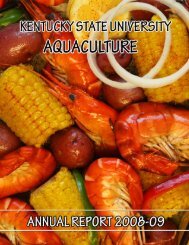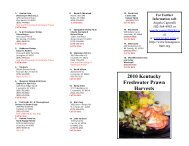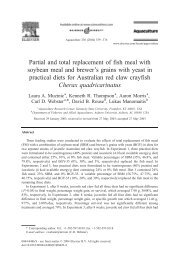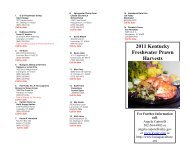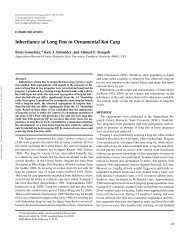Post-Harvest Handling of Freshwater Prawns - SRAC Fact Sheets
Post-Harvest Handling of Freshwater Prawns - SRAC Fact Sheets
Post-Harvest Handling of Freshwater Prawns - SRAC Fact Sheets
Create successful ePaper yourself
Turn your PDF publications into a flip-book with our unique Google optimized e-Paper software.
Southern RegionalAquaculture Center<strong>SRAC</strong> Publication No. 4831May 2011PRVI<strong>Post</strong>-<strong>Harvest</strong> <strong>Handling</strong><strong>of</strong> <strong>Freshwater</strong> <strong>Prawns</strong>James H. Tidwell 1 and Shawn Coyle 1The freshwater prawn (Macrobrachium rosenbergii) isconsidered a new product in the U.S. and many parts <strong>of</strong>the world. Because many consumers are not yet familiarwith freshwater prawns, it is important for producers touse proper handling procedures to ensure that the productis appealing to consumers.<strong>Prawns</strong> kept alive after harvest will not lose quality,though it can be quite challenging to keep large numbers<strong>of</strong> harvested prawns alive in tanks for an extended length<strong>of</strong> time. If the animals are not going to be held or soldalive, natural degradation will begin once the animalsare killed. The major causes <strong>of</strong> product degradation afterdeath are the effects <strong>of</strong> bacteria and/or enzymes. Theseare the processes that must be controlled or slowed toprotect product quality.Many bacteria come initially from the prawn’sexternal environment (i.e., the pond water at harvest).Enzymes come primarily from inside the prawns themselves.The enzymes that degrade the product are mainlydigestive enzymes located in the prawn’s “head.” Theseenzymes help the prawn digest its food. After death, thesesame enzymes can begin to “digest” the prawn’s tail meatif the process is not interrupted. This can cause the tailmeat to become mushy. <strong>Prawns</strong> are much more susceptibleto this problem than marine shrimp. However, ifprawns are handled properly—including deheading themquickly after harvest—they can be stored as long as orlonger than marine shrimp.Both <strong>of</strong> the degradation processes (bacterial andenzymatic) are slowed by thoroughly washing harvested1Division <strong>of</strong> Aquaculture, Kentucky State Universityprawns and reducing their temperature. So the object isto get the product clean and keep it clean and get it coldand keep it cold. Lowering the temperature slows bacterialgrowth and reduces enzyme activity. If the prawnsare not to be kept alive, chill them thoroughly andquickly. But do not let them sit in water, even ice water.When whole prawns or prawn tails are held on ice, itshould be drained ice so that enzymes and bacteria areflushed away from the product.Specific recommendations for handling freshwaterprawns after harvest depend on the product form (e.g.,live, whole-on-ice, fresh tails, frozen tails).<strong>Harvest</strong>ingProduct quality can be affected by the way theanimals are treated during the pond harvest process.<strong>Prawns</strong> should be removed from the ponds in a healthystate and as clean as possible, no matter what the finalproduct form. To accomplish this, thorough planning isrequired. At least 1 week before harvest, finalize plansfor obtaining the necessary equipment and labor. Whileneeds may vary according to site, all equipment necessaryfor harvesting, washing, grading, processing and storingmust be ready.It is important to determine accurately the timerequired to drain the pond so that harvest activities canbegin promptly when paid workers arrive.<strong>Prawns</strong> tolerate harvest conditions best when watertemperatures are 70 to 72 °F. If too warm, their metabolismis higher and they can stress (or die) more quickly.Also, warm water holds less oxygen than cool water.
Dissolved oxygen levels should be monitored during ponddrawdown; oxygen levels become most critical whenprawns are concentrated in the catch basin. Dissolvedoxygen should be maintained at ≥ 5 ppm throughoutdraining and harvest. Flushing clean, oxygenated waterinto the catch basin during harvest can be helpful. Asmall, floating, fountain-type aerator in the catch basinduring harvest can help keep the prawns in the best conditionpossible.<strong>Prawns</strong> cannot be efficiently removed from pondswith traps or seines. Even with a properly designed andconstructed pond and an efficient seine crew, more thanhalf <strong>of</strong> the prawns may be left in the pond. Because <strong>of</strong> this,almost all prawn ponds are designed with catch basinsto concentrate the prawns as the water is drained. Catchbasins may be internal or external.Interior basins<strong>Prawns</strong> can be harvested by draining the water downand concentrating the prawns into a catch basin inside <strong>of</strong>the pond at the drain end. <strong>Prawns</strong> are then removed witha small seine. The catch basin should be about 10 to 15 feetwide with a length about two-thirds the width <strong>of</strong> the pond(Fig. 2). The catch basin should be 18 to 24 inches deeperthan the pond bottom. The pond bottom should slope 1 to2 degrees to allow water to drain to the catch basin. Thedrain pipe should be located in the floor <strong>of</strong> the catch basinat its deepest point. A drain pipe 8 to 10 inches in diameterin a ½- to 1-acre pond will make the pond drain fasterand reduce the labor required to harvest the prawns.Interior basins are less expensive to build than exteriorbasins but prawns harvested from interior basins arelikely to have more mud on them and in their gill chambers.When the pond is drained prawns will hide underany weeds or equipment (such as aerators) in the pond,or in any type <strong>of</strong> rut or depression they can find. Workersshould not walk through ponds leaving deep footprints.Figure 1. Hand nets and baskets used at harvest.Basic harvesting equipment includes long-handleddip nets, mesh baskets, and scales (Fig. 1). The dip netsshould be sturdily constructed with metal handles on theframe throats for grasping heavy loads. Perforated plasticbaskets with a mesh <strong>of</strong> about ½-inch-square will retainprawns but allow water and debris to drain out quickly.If the mesh is too large, the prawn’s claws may break <strong>of</strong>f,which reduces the market value <strong>of</strong> the whole product. Thebaskets need strong handles to hold the harvested prawnsduring transfer to rinsing, holding or transport tanks.Baskets should be filled only one-half to two-thirds full toprevent damage to the prawns.Figure 2. Top: Schematic <strong>of</strong> a prawn pond with an internal catch basin.Bottom: <strong>Harvest</strong>ing from an internal catch basin.2
Exterior basinsAnother harvest method is to collect the prawnsin a basin outside <strong>of</strong> the pond as they are flushed outthrough the drain pipe (Fig. 3). The external collectionbasin should be large enough to retain the entire harvest<strong>of</strong> prawns. Make sure the exit pipe out <strong>of</strong> the catch basinis large enough to allow water to leave easily and notoverflow the basin. If possible, water should be routedto a reservoir pond for reuse. A net pen, constructed <strong>of</strong>heavy seine material and placed inside the basin, with a“sock” that attaches over the drain pipe, works well tocontain the prawns. This method <strong>of</strong> harvest requires anadditional source <strong>of</strong> water for flushing prawns strandedon the pond bottom or inside the drainpipe. <strong>Prawns</strong>harvested from external basins are <strong>of</strong>ten cleaner thanthose harvested from internal basins.Figure 3. Top: Schematic <strong>of</strong> a prawn pond with an external catch basin.Bottom: <strong>Harvest</strong>ing from an external catch basin.Figure 4. Purge tanks used to remove mud and debris.Cleaning and cooling<strong>Prawns</strong> should be moved out <strong>of</strong> the catch basin andinto purge tanks (rinse tanks) as quickly as possible (Fig.4). These tanks are placed next to the pond and filledwith clean water for washing the mud and debris <strong>of</strong>f theanimals. It is helpful to have a series <strong>of</strong> four to eight rinsetanks in a row. Baskets <strong>of</strong> prawns are dipped sequentiallyin the tanks and cleared <strong>of</strong> surface mud, becoming progressivelycleaner with each tank. <strong>Prawns</strong> are then movedto tanks with clean water and aeration where they areallowed to swim freely, removing mud from the gills andunder the carapace. About 2,000 to 3,000 gallons <strong>of</strong> clean,aerated water are needed for each 1,000 pounds <strong>of</strong> prawnsto be harvested.Live marketsThere is a demand for live prawns, especially in gourmetand ethnic markets. Live prawns sell at wholesale forabout $4.00 to $8.00 per pound, while final retail pricesare about $10.00 to $22.00 per pound. However, holdingand transporting live prawns can be challenging, especiallyif they were stressed during harvest.Live prawns must be marketed quickly because significantmortality and cannibalism can occur in holdingfacilities. If prawns are to be transported by a live hauler,schedule pick-up for the day <strong>of</strong> harvest if possible, or atmost 1 to 2 days after harvest. Keep the tank water temperatureat 70 to 72 °F and do not allow the temperatureto drop below 65 °F during the night. Tanks should bewell aerated and contain enough artificial substrate thateach animal has about 1 square foot <strong>of</strong> surface area. Panels<strong>of</strong> substrate should be at least 4 inches apart to allowthe prawns access to all areas <strong>of</strong> the tank.3
<strong>Prawns</strong> that have recently molted or are about tomolt are likely to be lost to aggression or cannibalism inholding tanks. This loss can be up to 10 percent <strong>of</strong> theharvested crop, which has a significant impact on pr<strong>of</strong>itability.Any animals that appear weak or s<strong>of</strong>t-shelled, orthat seem to be approaching a molt, should not be placedin the holding tanks but should be sold whole on-ice orde-headed on-ice, or cooked and consumed.Market-size prawns that have not been stressed duringharvest can be transported in hauling tanks for up to24 hours, at 1 pound per gallon, with more than 90 percentsurvival. Successful transport requires reducing thewater temperature to 68 °F and providing proper aeration.Adding artificial substrate to the hauling tank does notimprove survival. Again, animals must be in good conditionbefore transport. A holding period <strong>of</strong> 1 to 2 days afterpond harvest may be necessary to eliminate weak ands<strong>of</strong>t-shelled animals before transport. It may be beneficialto wait until pond water temperatures cool to 68 to 70 °Fbefore harvesting prawns destined for live markets. Keepin mind that if prawns are intended for live sales it isespecially important to aerate the catch basin and havean adequate supply <strong>of</strong> cool, clean, well-aerated water forholding the prawns before transport.Pond-bank salesEven if prawns are to be sold fresh on the farm, productquality is enhanced if those animals are quickly andhumanely killed and their body temperatures lowered asquickly as possible. Both <strong>of</strong> these objectives are accomplishedmost efficiently by chill-killing the animals in anice bath. It is not advisable to place live prawns directlyon ice or into a refrigerator because this lowers internaltemperatures too slowly.To properly chill-kill prawns, they are first cleanedin rinse tanks and purge tanks and then placed in thechill-kill tank, which contains clean, clear water with sufficientice added to create a slurry. About 1 to 1 ½ pounds<strong>of</strong> ice will be needed for each pound <strong>of</strong> prawns harvested.<strong>Prawns</strong> should be left in the chill-kill tank approximately20 minutes to cool sufficiently. Longer times are notrecommended because this can degrade the texture <strong>of</strong> thetail meat.To confirm that adequate cooling has occurred, coretemperatures <strong>of</strong> the prawn tails should be measured. Thisis done by removing one <strong>of</strong> the prawns from the slurryand inserting a thermometer directly into the center <strong>of</strong>the tail meat. The insertion site is the joint between thetail and the rear part <strong>of</strong> the “head.” If procedures areproperly followed, prawns will normally chill to a coretemperature <strong>of</strong> 34 to 36 °F within 20 minutes. Adding saltto the chill-kill tank can cause the temperature to dropbelow 32 °F and speed up the process.When placing prawns into the chill tank, it is helpfulto keep them in baskets or a mesh enclosure. If mixeddirectly with the ice, weighing prawns for customers willbe complicated by ice in the weigh basket.Once prawns are thoroughly chilled, they can beplaced on drained ice for delivery or customer pick-up.Shaved ice is best. The container should be packed withalternating layers <strong>of</strong> prawns and ice, with the bottomand top layer just ice. The drain must be kept open or thebottom <strong>of</strong> the cooler perforated so water can drain andprawns are kept above the ice melt. Whole prawns can beheld on drained ice for 2 days. Deheaded prawn tails canbe held on drained ice for up to 6 days, although MississippiState University researchers have reported goodquality for as long as 12 days.Fresh-tail marketWhile certain markets will pay a premium for live orwhole product, other markets insist on tail-only product.Even on-farm purchasers may not be willing to processprawns themselves. For a tail market, all the harvesting,washing and chill-kill steps previously described apply.Then, to dehead, simply grasp the head in one hand, thetail in the other, and pull and twist. If fresh tails cannotbe marketed within 5 days <strong>of</strong> harvest, they need to befrozen. <strong>Prawns</strong> destined for freezing should receive thesame care and attention as those destined for fresh sales.Processed prawns yield approximately 40 to 50 percenttail weight.Retail prices for prawn tails are about $12.00 to $20.00per pound. (However, selling whole prawns is usuallymore pr<strong>of</strong>itable than selling processed tails.) In marketswhere headless shrimp or prawns are both sold, freshwaterprawns can be readily distinguished from marineshrimp (family Penaeidae). The freshwater prawn’s secondtail segment overlaps the first and third segments on theoutside, while in marine shrimp each abdominal segmentis overlapped by the previous one (Fig. 5).Figure 5. A schematic illustrating how to differentiate a freshwater prawntail from a marine shrimp tail.4
Processing regulationsTo sell deheaded, peeled or value-added prawns onemust have processing facilities and follow procedures thatmeet local health and/or FDA standards. If the productsare to be sold directly to the consumer, an approved facilityis needed but a HACCP plan is not required. If soldwholesale to a distributor, a restaurant, or via interstatecommerce, the processing facility must comply with afood safety plan prepared according to the FDA HazardAnalysis and Critical Control Points (HACCP) program.(More information on HACCP is available in <strong>SRAC</strong> PublicationNo. 4900.) Unaltered prawns, such as those soldlive or whole-on-ice, are not covered by HACCP regulationsunless they are sold across state lines.Mobile processing unitIn Kentucky, prawn processing is done throughoutthe state in simple on-farm processing facilities or bycommercial processors. Producers who lack access tothese facilities have a HACCP-approved, low-cost alternative—thestate-wide mobile processing unit (MPU)owned by Kentucky State University (KSU). The MPU isapproved by county health departments for processingfish, shrimp and other farm-raised animals. No productliability insurance is required <strong>of</strong> the processor under themanagement agreement with KSU. Advance reservationsand a nominal deposit are necessary to guarantee specificdates. Currently, the MPU costs $100 per day to rent andoperators are required to take a one-time training courseto learn safe and sanitary operating procedures. Thecourse costs $75, and there is a $50 annual renewal fee.Figure 6. A mobile processing unit.The MPU can accommodate six workers and a manager,with one additional person operating the holdingand chill-killing tanks outside <strong>of</strong> the MPU. The MPU isequipped with a receiving table, three-compartment sink,separate hand washing sink, ice storage bins, a packingtable, two ice bath tanks, and two processing tables. Itmust be located and “hooked up” at a qualified dockingstation, which consists <strong>of</strong> a level pad (gravel or concrete),with 220-V, ground-fault interrupted, 50-amp electricalservice within 30 feet and an approved water source.Because Kentucky has only one MPU available, it hasprimarily served as a temporary arrangement for beginningproducers. Most large-scale producers either havetheir own on-farm processing facilities or hire commercialprocessors.YieldThe tail yield <strong>of</strong> freshwater prawns depends on sexand size. As prawn size increases, the percentage <strong>of</strong> tailmeat decreases. Females yield a significantly larger proportion<strong>of</strong> tail meat than males, independent <strong>of</strong> size. Theclaws <strong>of</strong> females are small and have a relatively constantrelationship to the total weight (2.8 percent). Male clawsare larger, and the claw percentage increases with bodyweight. Thus, in males <strong>of</strong> 20 g the claws are 4.3 percent <strong>of</strong>total weight, while in 100-g males the proportion is 14.3percent. The overall average yield <strong>of</strong> tail meat in freshwaterprawns is lower than that <strong>of</strong> marine shrimp (48percent as opposed to 63 percent). However, the yield <strong>of</strong>edible meat in prawns is greater than in other importantcrustaceans such as lobsters (36 percent), crayfish (15 percent),and crabs (15 percent), or in fish such as tilapia (35percent) and catfish (40 percent).CompositionThe chemical composition <strong>of</strong> prawn tail meat isapproximately 76 percent moisture, 21 percent protein,1 percent ash, and less than 1 percent lipid. <strong>Prawns</strong> arereported to have lower levels <strong>of</strong> cholesterol and iodinethan marine shrimp. High concentrations <strong>of</strong> cholesterolhave deterred some people from eating shrimp, and iodineis the source <strong>of</strong> a common allergy related to seafoodconsumption. Researchers at Mississippi State Universityreported that the cholesterol content <strong>of</strong> prawn tail tissueaveraged 0.85 mg/g compared to 1.25 mg/g in marineshrimp, while iodine values were 0.14 ppm for mediumsizedprawns (30 g whole weight) compared to 0.80 ppmfor marine shrimp. With these findings, freshwaterprawns might be promoted as a more healthful product.5
Size gradingDue to a complicated social structure, there will bea large range <strong>of</strong> prawn sizes in a pond at harvest, andthis affects marketing. In some markets, prawns are soldas mixed sizes for a fixed price. In other markets, pricesdepend on size, and prawns below a minimal size may beconsidered unmarketable. These prawns may be consumedby the producer or discarded. In tropical regionswith a year-round growing season, size variation canbe managed by selectively harvesting large individuals.In temperate regions, however, the entire population isharvested at once because <strong>of</strong> temperature limitations, and10 to 20 percent <strong>of</strong> the harvested population may be belowmarket size (less than 20 g). Most small-scale producersin the U.S. market their prawns fresh on the pond bankand do not usually grade them by size. Larger producers,who do not sell their entire crop fresh, typically do sometype <strong>of</strong> size grading during processing. However, mostprawn producers grade into only three or four size categories,while many restaurants are more accustomed to themore than ten categories common with marine shrimp.A significant amount <strong>of</strong> research has been done oncontrolling size variation during pond growout. Addingmore substrate to growout ponds has been shown toreduce size variation, as has size grading seedstock beforestocking. Monosex culture also shows promise. Whilethese management techniques can reduce size variability,they do not eliminate the problem and have not beenwidely implemented in commercial production.If U.S. farm-raised freshwater prawns are to be producedon a large commodity scale, and break away fromcurrent niche marketing, more consistent size gradingwill be required. This will likely require a combination <strong>of</strong>biological management during production and mechanicalsize separation during processing to achieve the sizeconsistency required by restaurant and retail grocermarkets.Frozen storageDeciding whether or not to freeze prawns dependsmainly on the length <strong>of</strong> time between harvest and consumption.If they will not be cooked within 5 days <strong>of</strong>harvest they should be frozen. Freezing ensures thatthe growth <strong>of</strong> microorganisms is stopped and autolyticenzymes become almost inactive. <strong>Freshwater</strong> prawnshave a different muscle structure than marine shrimpand require more care during handling, processing, andfrozen storage.The quality <strong>of</strong> frozen prawns is largely dependenton the storage temperature and the rate <strong>of</strong> freezing. Thedeterioration <strong>of</strong> prawns caused by microorganisms ceasesat temperatures below 14 °F (the operating temperature<strong>of</strong> most residential freezers). However, enzymatic activitycan continue, albeit very slowly, at this temperature. Forlong-term storage, it is advisable to use commercial freezerswith temperatures lower than 4 °F, especially whenfreezing whole prawns (with the heads intact), as enzymesresponsible for protein breakdown are concentrated in thehead.The rate <strong>of</strong> freezing determines the size <strong>of</strong> the icecrystals that form in the cells within the meat. If the temperatureis decreased too slowly, relatively large ice crystalsform. This causes intracellular fluids to leak out <strong>of</strong> themuscle tissue, thus drying the product and reducing shelflife. If the temperature is quickly decreased from 30 °F to23 °F, smaller ice crystals form, reducing moisture loss.Using specialized equipment such as commercial blastor cryogenic freezers will ensure the best quality whenfreezing freshwater prawns. Cryogenic freezing is recommendedfor prawn tails. Blast freezing <strong>of</strong> pre-packagedprawns is recommended for whole prawns to prevent theclaws from breaking.In reality, most small producers use residential freezersto freeze and store prawns. This can affect the texture<strong>of</strong> the flesh if not done properly. Packaged prawns shouldbe in contact with the base <strong>of</strong> the freezer or the shelveswhere the refrigerant liquid passes. Packages should besmall. When the thickness <strong>of</strong> the packages increases, thetime required to freeze them thoroughly also increases.Packages must not be stacked upon one another, as thisalso slows freezing, especially in packages near the center<strong>of</strong> the stack.A practical substitute for commercial freezing equipmentis a walk-in freezer with wire rack shelves and fansfor air circulation. Open exposure and rapid air flowaround the product greatly increase the freezing rate,simulating the conditions <strong>of</strong> a commercial blast freezer.Results can be enhanced by spraying unpackaged productwith water during the freezing process to create a protectiveglaze. Water glazing is <strong>of</strong>ten used to protect prawnsfrom freezer burn or desiccation during frozen storage.Small quantities (1 to 2 pounds) can be frozen inheavy “zipper top” freezer bags. After the prawns areweighed, they are placed in the bags and tap water isadded. The bag is then partially zipped closed, leavinga 1-inch gap. Water is squeezed out, and then the bag iszipped fully closed. This leaves the prawns coated in waterwithout having to freeze (or thaw) large amounts <strong>of</strong> water.Small-scale producers have begun using small plasticclam-shell or sandwich containers for freezing 1- and2-pound quantities in water. These small containers aremore puncture resistant and more easily stacked.6
<strong>Prawns</strong> also can be blanched before freezing. Blanchingconsists <strong>of</strong> exposing whole or deheaded prawns tosteam or boiling water long enough that the surface iscooked but the center is not. Blanching extends chilledshelf life by deactivating enzymes. It is also a desiredproduct form in some markets as the color is attractive(red) and the process greatly decreases the likelihood <strong>of</strong>mushiness. For blanching, cook times should not exceed3 to 4 minutes at 212 °F.If properly handled and frozen, prawns can be heldat temperatures below -4 °F or colder for up to 6 monthswithout noticeable loss <strong>of</strong> quality. <strong>Prawns</strong> that have beenproperly chill-killed, processed, and the tails frozen inwater have been stored frozen for more than a year withoutsubstantial quality loss. The product should be clearlylabeled and dated so that older product is used first.Proper thawingSince some amount <strong>of</strong> bacterial and enzymatic breakdownoccurred before freezing, proper thawing is also anessential step in ensuring the quality <strong>of</strong> frozen prawns.<strong>Prawns</strong> should be cooked from a frozen state or afterthawing in a refrigerator for no more than 8 hours. Thawingunder flowing water or in a microwave is not advised.For head-on product, slow thawing in a refrigerator forless than 8 hours keeps the claws intact but may result insome s<strong>of</strong>tening <strong>of</strong> the tail, especially near the head region.For best results, whole product should be only partiallythawed before cooking.If using prawn tails frozen in a block <strong>of</strong> water, it isbest to remove the frozen block from its packaging andplace it in a colander sitting in an empty bowl or pan inthe refrigerator. This will prevent the thawed product fromsitting in water. If the tails will be cooked immediately,flowing cold water can be used to “quick thaw” the blockjust enough to separate the tails. Again, only partially thawthe tails. Quality is best if there are still ice crystals in theflesh when the tails go into the pan or the pot.Repeated freezing and defrosting can produce amushy product. While this is a common practice withmarine shrimp in restaurants, it is a very bad practicewith prawns. Educate your buyers! Frozen product shouldbe packaged in such a way that the end user can defrostjust the amount needed for each occasion (as with individuallyquick frozen tails), without having to refreeze theremaining product.Conclusion<strong>Freshwater</strong> prawns are now produced in most stateswithin the southern region. However, many consumersare still not familiar with the product. It is essentialthat prawns be properly handled so that only high qualityproduct enters the market. In the past, problems withmushy texture, especially with frozen prawns, have beena concern. However, with proper harvesting and postharvesthandling, the consistent high product quality <strong>of</strong>the product can be ensured.7




